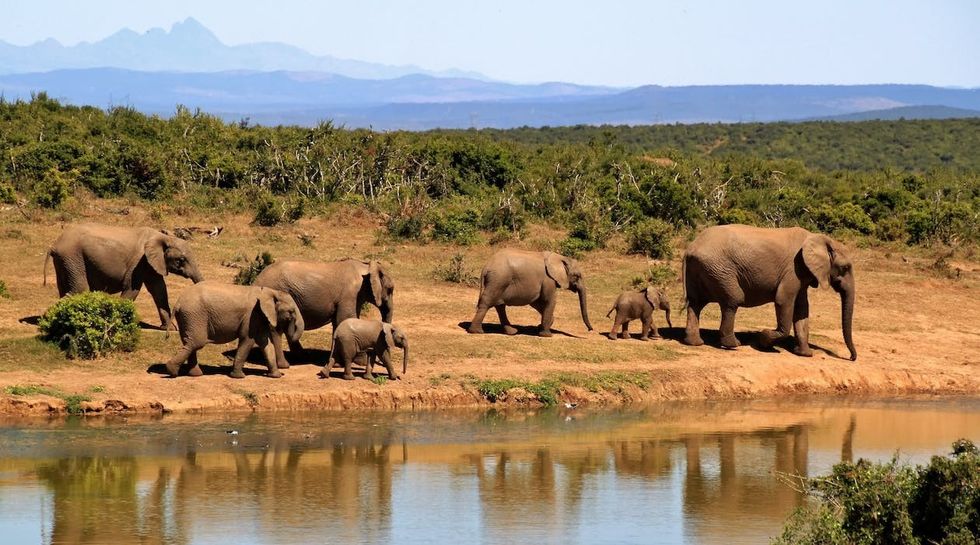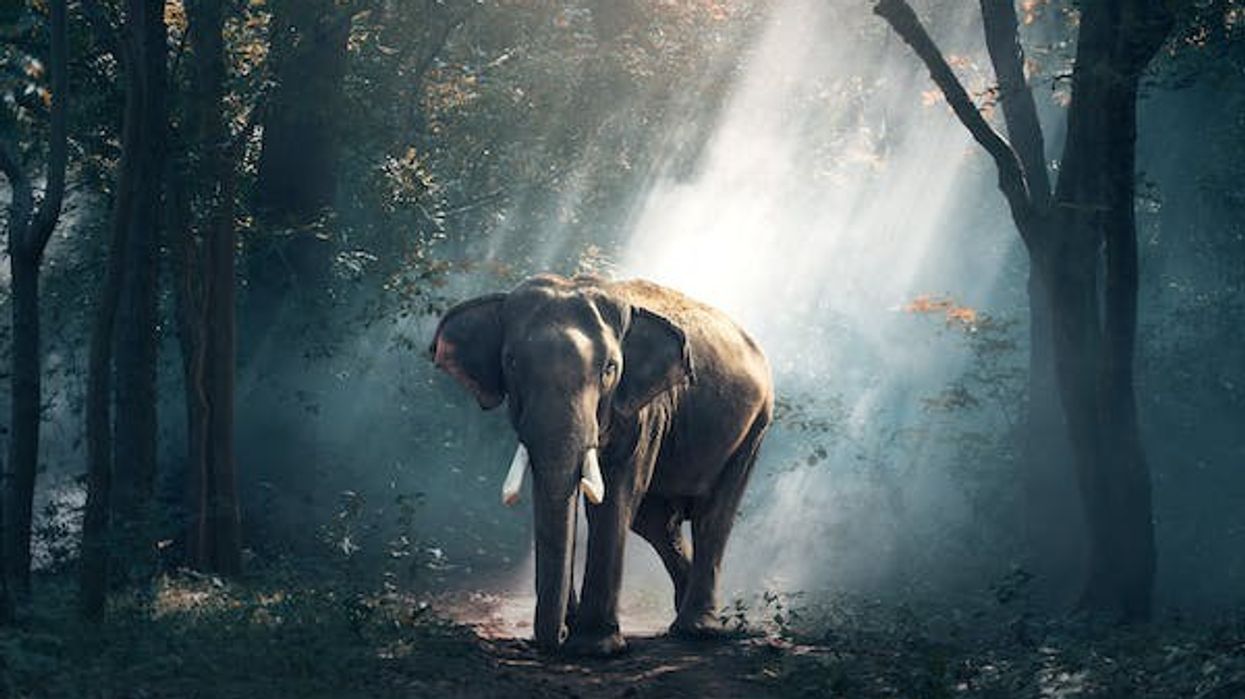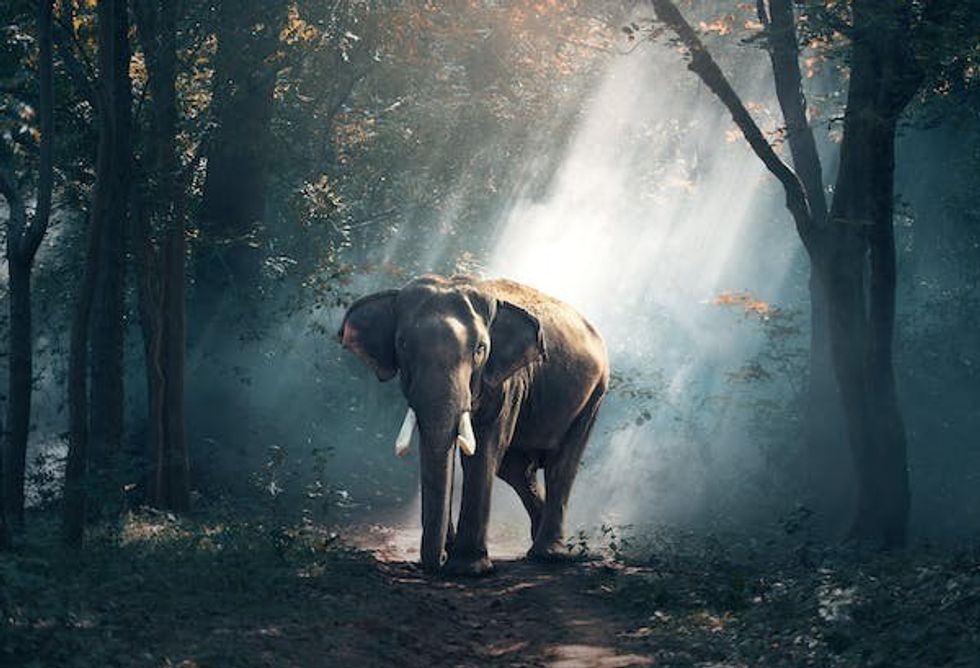17 African Forest Elephant Facts You'll Never Forget
Content
- What type of animal is an African forest elephant?
- What class of animal does an African forest elephant belong to?
- How many African forest elephants are there in the world?
- Where does an African forest elephant live?
- What is an African forest elephant's habitat?
- Who do African forest elephants live with?
- How long does an African forest elephant live?
- How do they reproduce?
- What is their conservation status?
- African Forest Elephant Fun Facts
- What do African forest elephants look like?
- How cute are they?
- How do they communicate?
- How big is an African forest elephant?
- How fast can an African forest elephant move?
- How much does an African forest elephant weigh?
- What are the male and female names of the species?
- What would you call a baby African forest elephant?
- What do they eat?
- Are they dangerous?
- Would they make a good pet?
- Did You Know...
- Why is the African forest elephant endangered?
- Different Types Of Elephants
The African elephants are divided into two groups: African forest elephants and African bush elephants.
These species are identical, but a thorough assessment would reveal some physical differences. The major difference is in size, with the African bush elephant appearing relatively bigger.
However, it has been scientifically proven that African elephant species have the same genetic root. Also, both species have been under threat of extinction. Some factors threatening African elephants' existence include poaching, habitat loss, conflicts with humans, and deforestation.
The International Union for Conservation of Nature (IUCN) stated in 2016 that there were about 415,000 elephants of African species in existence. The African foresft elephant is indigenous to the Western and Central African republic rain forests.
Therefore, The species develops adaption to its habitat with its straight truck. This feature prevents them from getting stuck in the woods. Also, their relatively smaller sizes make navigation through the forest easier.
The African elephants are divided into two groups: African forest elephants and African bush elephants.
These species are identical, but a thorough assessment would reveal some physical differences. The major difference is in size, with the African bush elephant appearing relatively bigger.
However, it has been scientifically proven that African elephant species have the same genetic root. Also, both species have been under threat of extinction. Some factors threatening African elephants' existence include poaching, habitat loss, conflicts with humans, and deforestation.
The International Union for Conservation of Nature (IUCN) stated in 2016 that there were about 415,000 elephants of African species in existence. The African foresft elephant is indigenous to the Western and Central African republic rain forests.
Therefore, The species develops adaption to its habitat with its straight truck. This feature prevents them from getting stuck in the woods. Also, their relatively smaller sizes make navigation through the forest easier.
African Forest Elephant Interesting Facts
What type of animal is an African forest elephant?
African elephants are the world's biggest terrestrial creatures. They are significantly bigger than their Asian counterparts and may be distinguished by their longer ears, replicating the African continent.
The African Forest Elephant is one of the continent's two Elephant subspecies. Although they were previously thought to be one species, scientists have discovered that there are two types of African elephants, both of which are endangered.
African forest elephants are known to be friendly creatures. Their family units comprise three to five elephants, most female relatives. A female often forms the family unit with her children or many females with their offspring.
Other group formations comprise two to eight elephants. Male calves leave the group when they reach maturity. However, females are philopatric and stay with their parental group.
Their tusks are straighter and point downward, and their ears are more oval-shaped. Forest elephants reproduce at a considerably slower pace than savanna elephants. Thus they cannot recover from population decreases as rapidly.
What class of animal does an African forest elephant belong to?
African Forest Elephants are classified under the Mammalia class of animals. This indicates that the African forest elephant is a mammal.
How many African forest elephants are there in the world?
Because of their fondness for deep forest environments, typical counting methods like visual identification are impossible. Their population is often determined using dung counts. Dung counts are based on the density and dispersion of excrement.
The estimated population of African forest elephants in 2022 is 200,000.
Where does an African forest elephant live?
The African forest elephants live in the forests of west and Central Africa. They can also be found in southern Africa. They live in migratory herds, roaming Africa's forests and grasslands, grazing for food and waterholes. This elephant species extends throughout the southwestern Central African Republic, northern Congo, southern Ghana, Gabon, southeast coast, and Cote D 'Ivoire.
What is an African forest elephant's habitat?
African forest elephants change habitats seasonally. They settle in swampy areas during the dry season, then move back to lowland rainforests in the wet season. Also, African forest elephants seek refuge in the rainforest reserves because local human populations persecute them.
The African forest elephant habitat is seasonal. Therefore, African forest elephants are usually found in the deep tropical jungle. Their smaller size helps them to travel more readily through the thick undergrowth than the bigger African Bush Elephant.
Thus, this elephant species' habitat includes rainforests, swamp forests, shrubland, savanna, and montane forests.
Due to the deep forest environment of African forest elephants, determining their home range size is complicated. The size of a home range will vary depending on area variables such as closeness to water and the quality of food supplies.
Who do African forest elephants live with?
African forest elephants co-exist peacefully with other mammals of similar interests. The African forest elephant habitat also features a unit of life known as 'herds.' The herds consist of affiliated females and their progeny. The matriarch is the head and is generally the oldest elephant in the group.
The African forest elephant involuntarily interacts with its habitat in various ways. These include the subsonic rumble that penetrates the earth when communicating with other animals over a distance. Also, the footprint lefts behind by this elephant specie serve as shelter for smaller animals.
How long does an African forest elephant live?
There is no conclusive information about the age cap of the African forest elephants. The factors that influence the life span of this elephant species include access to preferred vegetation and climate. The human factor is also a major determinant of their lifespan.
Data from previously established inclusive African elephant specie indicate natural lifespans of 65-70 years. The longest documented age for caged African elephants is 53 years old. On the other hand, the average longevity in captivity is approximately 33 years.
Conclusively, under natural circumstances, African forest elephants have a 60-70 years lifespan.
How do they reproduce?
Female African forest elephants have the longest gestation period of all mammals. Pregnancy in this specie lasts between 630–660 days. Also, This specie is known to be polygamous, with males competing for females in estrus. Therefore, the more dominant or bigger males mate with more females. The age of sexual maturity varies according to climate, diet, and environment.
Male African forest elephants do not attain sexual maturity until they are over 20. On the other hand, female African forest elephants reach sexual maturity after 10 or 11 years.
The heat period in male elephant species is known as musth. In male African forest elephants, there is a positive relationship between age and musth period. Therefore, older males musth for a longer period, while it is shorter in young ones.
The indication of musth in male African forest elephants includes the secretion of fluid between the ears and the eyes. They also walk with their tusks tucked in and their heads held high. They invite the females by flapping their ears to spread the musty odor.
They also brush the back of their heads on trees to leave a trail of the musty fragrance. Another unique heat sign is the musty rumble. However, this is louder in older males.
Reproductive cycle behavior in a female African forest elephant progresses through four phases. The early stage is characterized by wariness, followed by the estrous walk. The estrous walk is more noticeable because the female walks away from her group.
The walking pattern features the head held high and turned to the side. This gesture is believed to acknowledge the male pursuing her from behind. This character launches the third stage, which is the pursuit stage.
Consortship is the fourth and last stage of estrous behavior. The final stage features both sexes interacting physically. As the female approaches her lover, the male repels any other male.
The female African Forest Elephant births a single calf after a gestation period of approximately two years. The calf is then nurtured for two years before joining the herd when it is mature enough.
Females in African woodland elephant herds all help to care for the young. Young calves mostly remain within 16.5 ft (5 m) of their mother.
This proximity is maintained for up to 8 years, so mothers breastfeed and care for their kids for lengthy periods. The tusks of the African forest elephant calf will begin to develop after two years of birth.
What is their conservation status?
African forest elephants are threatened in most of their natural habitat today. This threat is attributable to deforestation and climate change. These human and natural factors have forced the majority of the elephant population into smaller pockets of their original habitat.
Forest elephant populations are believed to be more endangered, hence smaller than elephant populations in Africa. Also, increased human populations in the forested regions have forced out wildlife.
Therefore, the African forest elephant is classified as critically endangered.
To salvage the situation, the Central African Republic, Cameroon, and Congo environmental ministers constructed an elephant migration corridor in December 2000. This initiative aims to ensure free movement across borders in artificially natural elephant habitats.
African Forest Elephant Fun Facts

What do African forest elephants look like?
The African forest elephant is one of the existing elephant species of African elephants. The two were previously thought to be the same until some physical differences were noticed. The most obvious distinguishing feature is size.
The African forest elephant is noticeably smaller than the other African elephant specie. Male African forest elephants may grow to about 9 ft 10 in (3 m) tall.
In comparison, female African Forest Elephants can grow around 7 ft 10 in (2.4 m) tall. The African forest elephant also has a distinct size and shape, influenced by its different skeletal structure and skull.
Noticeably, the African forest elephant has rounded ears and straight tusks pointing downward. The ears serve a dual purpose: keeping them cool and as a hearing aid.
The trunk is a sensitive organ, predominantly innervated by the trigeminal nerve. The ivory tusks are known to be firm with a touch of pink. Also, the tusks can grow to be about 4 ft 11 in (1.5 m) long, weighing between 50-100 lb (22.7-45.4 kg).
African forest elephants have two finger-like structures like African bush elephant trunk tips. The trunk is a prehensile extension of the animal's top lip and nose.
It is so powerful because of its muscular structure that elephants can pull up to 3% of their body weight. It is used for smelling, making sounds, touching, eating, protecting, dusting, loading, drinking, and attacking.
This animal has nine toenails, five on the front limbs and four on each hind limb. African forest elephants grow four molar teeth, weighing around 11 lb (5 kg) and reaching approximately 12 in (30.5 cm) in length.
How cute are they?
African forest elephants are amazing creatures and friendly. The cuteness of the African elephants is affiliated with their friendly nature and size. An African elephant cannot be mistaken on sight because of its definitive features while alone or in the company of other animals.
How do they communicate?
African forest elephants, like other elephants, use low-frequency calls to communicate among widely separated social groupings. African elephants can distinguish a voice signal from a family member up to a distance of 1.5 mi (2.5 km).
However, they can discern better between 0.6-0.9 mi (1-1.5 km). However, given the difference in habitat layout, detection distances in African forest elephants may be shorter.
They also discover food sources by marking vibrations in the ground and using their sense of smell. African elephants, like other elephants, have excellent eyesight and touch sensitivity through their trunks and skin.
How big is an African forest elephant?
The African forest elephant is small compared to the other two elephant species. African forest elephants have heights ranging between 8.2-13 ft (2.5-3.9 m). They also have lengths ranging between 63-112.6 in (160-286 cm).
How fast can an African forest elephant move?
One of the most obvious elephant facts in that they are not fast in movement because of their size. However, an African forest elephant in its natural habitat can reach a 24.2 mph (39 kph) peak.
How much does an African forest elephant weigh?
An African forest elephant can have a weight range of 5,500-15,400 lb (2,500-6985 kg).
What are the male and female names of the species?
An adult male African forest elephant is known as a Bull. The female African forest elephants are called Cows.
What would you call a baby African forest elephant?
A baby African forest elephant is known as a calf.
What do they eat?
African forest elephants are herbivorous. Therefore, the African forest elephant diet revolves around grasses, leaves, seeds, fruits, and tree bark.
Are they dangerous?
African forest elephants are friendly like other Elephant species. However, as the world's largest and strongest land mammals, they may be dangerous, especially in unfamiliar circumstances. The danger they pose is often contingent. Also, a male African forest elephant in musth is perceived as dangerous.
Would they make a good pet?
Elephant conservation is an initiative that should be encouraged because of their roles in the ecosystem. However, domesticating an African forest elephant is complicated because of the roles already played by humans in the extinction of the specie.
Also, keeping an African forest elephant as a pet would be challenging because of the animal's size. The unpredictability and hostility of a male African forest elephant is another point against keeping the species as a pet.
Did You Know...
Elephants are smart creatures with some degree of humanity. They can exhibit benevolence, playfulness, sadness, art, music, compassion, and self-awareness.
Elephants enjoy swimming! Their trunks aid this exercise because they serve as snorkels when swimming in deep water.
African forest elephants are frequently observed standing over their sleeping young, blocking the sun, and smothering their calves in the sand to shield them from the hot heat.
The Greek Elephas, which means 'ivory', is the origin of the term 'elephant'.
Elephants are considered better at tracking different things in 3D space than humans.
African elephants have ears like the diagrammatic replica of Africa.
Why is the African forest elephant endangered?
Due to human expansion, deforestation forces African forest elephants out of their natural habitat. This human factor is accompanied by lack of elephant conservation drive to create an alternative for the elephant populations.
Also, humans' indiscriminate hunting for elephant tusks has left the elephant species vulnerable. Poaching for ivory tusks has negatively affected the chances of survival for savanna elephants and forest elephants alike. Every national park inhabiting the African forest elephant and African bush elephant in Africa has been the target of poachers in recent years.
Different Types Of Elephants
There are three species of elephant. These species form the existing types of elephant populations. They include:
- African forest elephant
- African bush elephants or savanna elephants
- Asian elephant
Each specie is distinguished by its physical attributes and natural habitat.
We Want Your Photos!
More for You
Sources
https://www.nationalgeographic.com/animals/mammals/facts/african-elephant
https://www.worldwildlife.org/species/african-forest-elephant
https://animalcorner.org/animals/african-forest-elephant/https://www.4elephants.org/blog/article/african-bush-elephants-vs-african-forest-elephants
https://animalia.bio/african-forest-elephant
https://www.nature.org/en-us/get-involved/how-to-help/animals-we-protect/african-bush-elephant/
https://a-z-animals.com/animals/african-forest-elephant/
https://www.iucn.org/news/species/202103/african-elephant-species-now-endangered-and-critically-endangered-iucn-red-lis
https://www.blueplanetbiomes.org/african_forest_elephant.phphttps://animalia.bio/african-forest-elephant
https://animaldiversity.org/accounts/Loxodonta_cyclotis/
See All
Bachelor of Science specializing in Public Administration

John AkinrinadeBachelor of Science specializing in Public Administration
John is a highly qualified professional, holding a degree in Public Administration and a Diploma in Local Government Studies from Obafemi Awolowo University. He is also a qualified Chartered Accountant. With a diverse background in finance and writing, John has been producing high-quality copy as a content producer and copywriter for several years, both in the UK and Nigeria. John's unique combination of financial expertise and writing prowess allows him to produce compelling, well-researched content that is both informative and engaging.
Disclaimer
1) Kidadl is independent and to make our service free to you the reader we are supported by advertising. We hope you love our recommendations for products and services! What we suggest is selected independently by the Kidadl team. If you purchase using the Buy Now button we may earn a small commission. This does not influence our choices. Prices are correct and items are available at the time the article was published but we cannot guarantee that on the time of reading. Please note that Kidadl is a participant in the Amazon Services LLC Associates Program, an affiliate advertising program designed to provide a means for sites to earn advertising fees by advertising and linking to Amazon. We also link to other websites, but are not responsible for their content.
2) At Kidadl, we strive to recommend the very best activities and events. We will always aim to give you accurate information at the date of publication - however, information does change, so it’s important you do your own research, double-check and make the decision that is right for your family. We recognise that not all activities and ideas are appropriate for all children and families or in all circumstances. Our recommended activities are based on age but these are a guide. We recommend that these ideas are used as inspiration, that ideas are undertaken with appropriate adult supervision, and that each adult uses their own discretion and knowledge of their children to consider the safety and suitability. Kidadl cannot accept liability for the execution of these ideas, and parental supervision is advised at all times, as safety is paramount. Anyone using the information provided by Kidadl does so at their own risk and we can not accept liability if things go wrong.
3) Because we are an educational resource, we have quotes and facts about a range of historical and modern figures. We do not endorse the actions of or rhetoric of all the people included in these collections, but we think they are important for growing minds to learn about under the guidance of parents or guardians.







